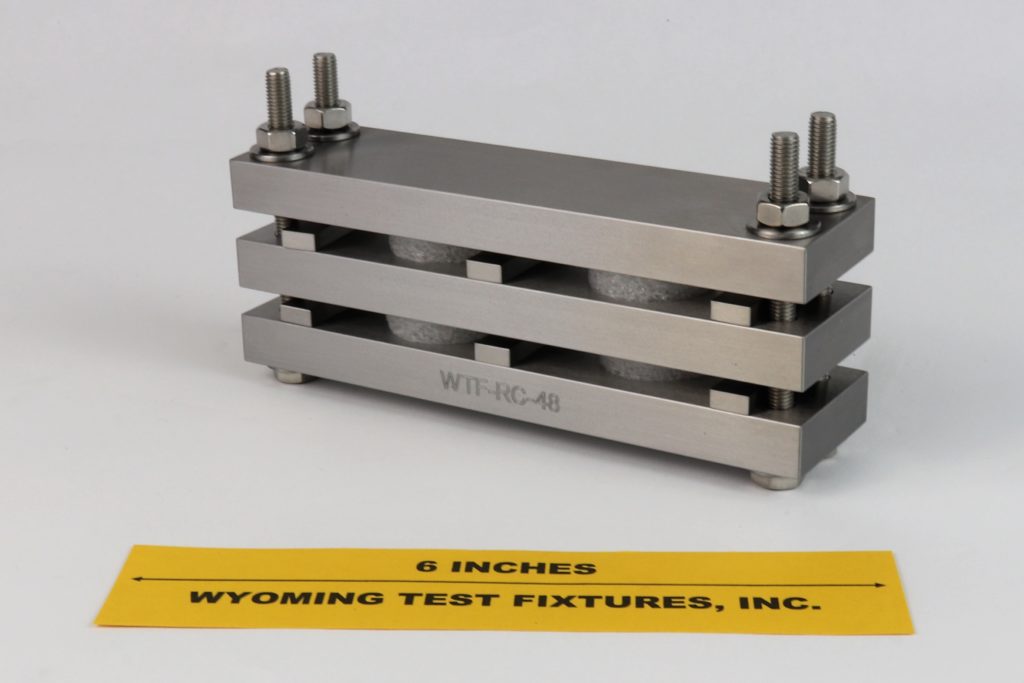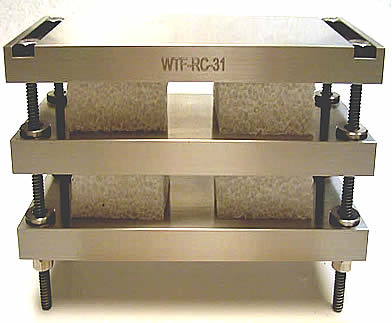Rubber Compression Set (ASTM D395)
Model No. WTF-RC (Stainless Steel)

Fig. 1: Assembled fixture without specimen installed, method B - compression set under constant deflection.
ASTM D395 (Reference 1) governs the testing of rubber and similar materials intended for use in applications in which the material will be subjected to compressive stresses in either air or a liquid medium. There are two test methods covered in the standard, viz., Method A – Compression Set under Constant Force, and B – Compression Set under Constant Deflection. Unless otherwise stated, Test Method B is to be used.
A typical Test Method B test fixture is shown in the following photograph. It consists of three plates, with three spacers between each pair of plates. The spacers maintain a fixed deflection of the specimens when the four bolts are tightened. The plates are 6 in. long, 1.5 in. wide, and ½ in. thick.
Type 1 specimens are 1.14 in. in diameter and 0.49 in. thick. Type 2 specimens are 0.51 in. in diameter and 0.24 in. thick. For Type 1 specimens the spacer bars are to be 0.375 in. thick, and for Type 2 specimens 0.1770 in. thick. This induces approximately 25 percent compression in each specimen. To achieve this, the spacer bars are rectangular in cross section.
The standard fixture will accommodate a maximum of four Type 1 specimens or eight Type 2 specimens, although fewer specimens can be tested, if desired. After the specimens are placed in the four openings of the fixture as desired, the screws are tightened to bring the plates against the spacer bars. The fixture is then placed in an oven at the required temperature for the specified time. A suggested time is either 22 or 70 hours. The specimens are then immediately removed from the fixture and allowed to cool for 30 minutes, at which time thickness measurements are taken. The compression set is then calculated.
If desired, fixtures conforming to other standards, or of non-standard sizes and/or configurations can be designed and fabricated to satisfy a customer's special requirements.
An example is shown in Fig. 2. This particular fixture conforms to the general requirements of ASTM D3574 (Reference 2). For the specific fixture shown, the 1 in. thick foam specimens are to be compressed by 90 percent, subjected to an elevated temperature for 22 hours, released and the resulting compressed thickness measured after 30 to 40 minutes recovery time at room temperature. The relatively thin, washer-like stops around each of the four clamping screws can be seen in the photo.

Fig. 2: Foam Compression Set Test Fixture (ASTM D3574), method D - constant deflection compression set.
Source of Additional Information:
1) ASTM Standard D395-03 (2003), "Standard Test Methods Rubber Property – Compression Set," American Society for Testing and Materials, West Conshohocken, Pennsylvania (first issued in 1934).
2) ASTM Standard D3574-11 (2011), "Standard Test Methods for Flexible Cellular Materials - Slab, Bonded, and Molded Urethane Foams," American Society for Testing and Materials, West Conshohocken, Pennsylvania (first issued in 1977).

